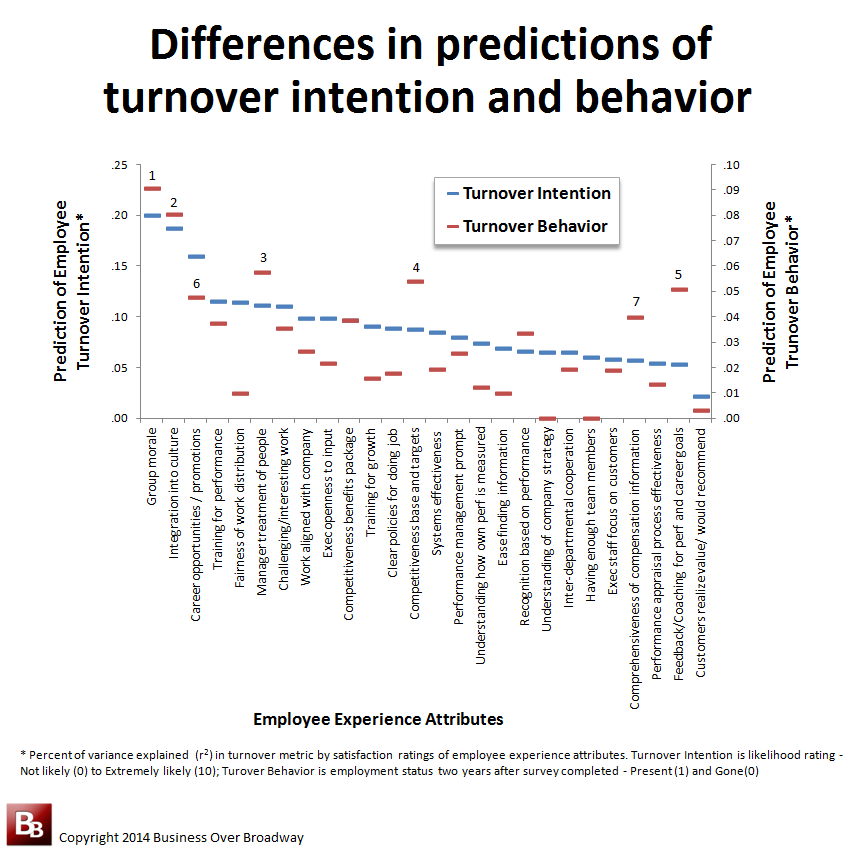Reducing employee turnover is an important way to improve how a company performs. It is estimated that employee turnover costs companies 16% of the annual salary (< $35K) of lower paying jobs and up to 75% of annual salary (> $75K) of higher paying jobs. These costs comes in many different forms, including the cost due to lost knowledge / lower productivity, hiring and training new employees, lost productivity from overworked staff who remain and poor customer service.
Consequently, business leaders are looking for ways to decrease employee churn by improving the employee experience. This exercise is one of identifying those facets of work (employee experience attributes) that impact employee turnover and ensuring your employees are satisfied with those facets. Identifying these important employee experience attributes is typically accomplished through correlating employee satisfaction with customer turnover. Employee satisfaction is usually measured using an employee survey. Employee turnover, however, can be measured two different ways.
Two Faces of Employee Turnover
Before we try to uncover what employee experience attributes impact employee turnover, we need a measure of employee turnover. We have two approaches: objective approach and subjective approach. In the objective approach, we simply look at employee behavior as our measure of employee turnover. The subjective approach involves asking employees to tell us their intentions to leave employment within a given time frame. This question typically appears in employee surveys.
Are these measures equivalent? Will our survey analysis be different depending on what type of employee retention metric we use?
Results
I have one client (startup B2B technology company) who had access to both types of employee turnover metric. The employee survey included a question that asks employees to indicate how likely they were to leave the company in the next 12 months, using a 0 (Extremely likely) to 10 (Not at all likely) scale. I also had each respondent’s employment status two years later (stay = 1; leave = 0) as our objective measure of employee turnover. No distinction was made for voluntary vs. involuntary turnover.
In the employee survey, employees were asked to rate their satisfaction with 26 employee experience attributes (e.g., Group morale, Work aligned with company).
A total of 137 employees completed the survey and their responses were used in the analyses.
Employee Turnover Metrics are not the Same
The correlation between the two turnover metrics was .31, suggesting that they each measure something unique. Next, I correlated the satisfaction ratings of the 26 employee experience attributes with the two measures of employee turnover. On average, satisfaction with the employee experience was more strongly related to turnover intentions (average r = .30) than to turnover behaviors (average r = .16).

Figure 1. The type of employee turnover metric you use (intention vs. behavior) will impact your analytic results.
Employee Turnover Results May Vary
Figure 1 reflects how well each of the 26 attributes correlates with each type of employee retention (graph presents r² values). The top drivers of turnover intentions were different than the top drivers of turnover behavior. Top drivers of turnover intention were:
- Group morale
- Integration into culture
- Career opportunities / promotions
- Training for performance
- Fairness of work distribution
- Manager treatment of people
- Challenging / interesting work
The top drivers of real turnover behavior were:
- Group morale
- Integration into culture
- Manager treatment of people
- Competitive base and targets
- Feedback / Coaching for performance and career goals
- Career opportunities / promotions
- Comprehensiveness of compensation information
Summary and Conclusions
Intentions are not the same as real behaviors. What people say they will do may not match their actions. The current analysis shows how the use of different turnover metrics (i.e., turnover intentions and turnover behavior) will lead to vastly different results, impacting your knowledge and consequently your decisions to manage employee turnover.
First, objective and subjective employee retention metrics measure different things. Self-reported intentions of leaving and the actual act of leaving are not equivalent.
Second, the use of turnover intentions over-inflates the importance of the employee experience on employee turnover. When we predict real employee turnover, we see that employee satisfaction with the employee experience is less important (has a lower correlation with employee turnover). In a prior study, I found a similar results looking at different types of measures of customer loyalty. When the measurement of customers’ recommending behavior was more subjective (i.e., intentions of recommending) than objective (i.e., count of people you referred), we saw higher correlations between customer experience and the recommend metric. The correlations between your measures of satisfaction and self-reported loyalty are due, in part, to the common method of measurement used to measure both (i.e., self-reported).
Also, we saw that top drivers of employee turnover depend on how we measure employee turnover. Using the intention metric, we concluded that compensation is not a relatively important factor to turnover. However, we see that compensation is a top predictor of whether an employee actually stays or leaves. Carefully consider the quality of the loyalty measures you use in your analysis and know their limitations. Generally speaking, loyalty measures (customer, employee and partner) can be captured through objective means (i.e., observing how they behave) and through subjective means (i.e., asking likelihood of behaving). Be cognizant of this fact when analyzing your data. The outcome of your analysis is dependent on how you measure your variables.
Whenever possible, however, use measures of real employee turnover as an outcome measure to verify the findings of self-reported intentions. While no company has a year to wait to analyze their employee survey data to identify drivers of employee turnover (after all, the use of self-reported behavioral intentions does provide some useful insights about the causes of employee turnover), the use of more reliable and valid metrics will give you better insights. If you are able, validate your survey results using more objective metrics of retention later in the year.
What kind of employee turnover metrics do you use?




 Beyond the Ultimate Question
Beyond the Ultimate Question Measuring Customer Satisfaction and Loyalty (3rd Ed.)
Measuring Customer Satisfaction and Loyalty (3rd Ed.)
[…] week, I compared two employee turnover metrics. One metric was a self-reported measure gathered through surveys. The other metric reflected the […]
[…] week, I compared two employee turnover metrics. One metric was a self-reported measure gathered through surveys. The other metric reflected the […]